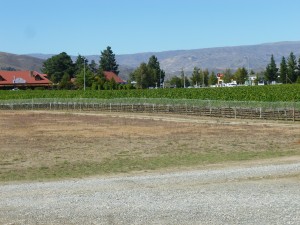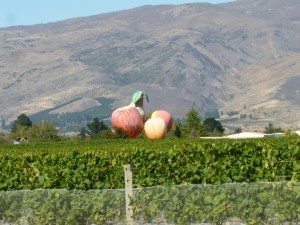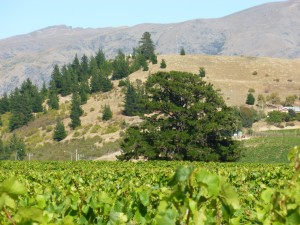SOUTHERN BELLES—WOOING TREE ESTATE, CROMWELL TOWN.

When we call this estate ‘Cromwell Town’ that is exactly what we mean, the vineyard is literally in the town as you can see from the picture to the side, houses hotels and a shopping centre just beyond the vines! The winery is even further into the town, not far from Hoydens in a small industrial estate, ideal accommodation, with lots of space, and air conditioned. This picture was taken from the steps of the cellar door where we met with owner Steve Farquharson, you can see here from the brown hills and car park just how dry it was; in fact whilst we were in Otago a ‘State of Drought’ was officially declared by the NZ government!
We first came across Wooing Tree wines through our old friend Mike Stead when they were imported by the ill-fated GVSN Imports and Mike and another old friend Jenny Gardener worked for them. The winemaker at that stage was Carole Bunn who was there at the start of and ran the VINPRO, a contract winery in Cromwell and made not just Wooing Tree but Shaky Bridge and Tarras wines and many more. The winemaker is now Peter Bartle who started in 2010. Peter began in Hawkes Bay and after graduating with honours spent time at Villa Maria, Joseph Phelps Vineyards in Napa, Forrest Estate in Marlborough, and Olssen in Central Otago before spending 6yrs at Peregrine, Gibbston Valley, quite a CV! For those who have retained the notes from City Beverage Friday Tasting refer to 146: City Bev Co FRIDAY TASTING 12.10.2007- ‘NEW ZEALAND DOUBLE ‘IN PERSON’ TASTING’ which give a complete run down on the Cromwell situation as it was then with both Carole and Hayden speaking. Things have changed a lot since then!
Editor’s Note: we are looking at how to make all the CBC notes available through the ‘Odd Bottle Travels’ site so watch this space!
The vineyard was purchased in 2002, and the ubiquitous Otago viticulturist Robin Dicey helped set-up the vineyard, planting roughly 44,000 vines. Of the 26 ha single vineyard site, 16ha is planted in mainly Pinot Noir of multiple rootstocks using premium clones, 5, 6, 115, 667, 777 to give variety and complexity, to minimise risk of phylloxera they used no natural rootstock, all the vines are grafted on to American briars. 2005 saw the first vintage aiming for a small yield of about 1.5 tonnes per ha, but it was a very cold and wet flowering, resulting in poor fruit set and even lower yields, very small bunches and lots of work, however the final had great colour and concentration. The second vintage in 2006 was where City Beverages came in, our first vintage via Mike Stead. Totally opposite to the first, with flowering and fruit set perfect, the ideal 2 bunches per shoot, which were large and with lots of berries matured by nice, warm and dry weather leading to a harvest in late March nearly a month earlier than 2005. The early harvest enabled the grapes to ripen to perfection thus giving a great first vintage for the UK.
 When we first met Hayden in Cromwell he said “see you under the fruit” and we wondered what the hell he was talking about. As you can see (right) we found out later that the fruit market on the main road through town has had created a big ‘fruit sculpture’ which is so prominent that it has become the local meeting place! Viewed across the Wooing Tree vineyard there is almost something vaguely Pythonesque about them! What you can also see in this picture are the nets which are common practice in NZ and Aus. We probably don’t need them quite so much in Europe especially in France where they practice the alternate strategy of “if it moves shoot and eat it”!
When we first met Hayden in Cromwell he said “see you under the fruit” and we wondered what the hell he was talking about. As you can see (right) we found out later that the fruit market on the main road through town has had created a big ‘fruit sculpture’ which is so prominent that it has become the local meeting place! Viewed across the Wooing Tree vineyard there is almost something vaguely Pythonesque about them! What you can also see in this picture are the nets which are common practice in NZ and Aus. We probably don’t need them quite so much in Europe especially in France where they practice the alternate strategy of “if it moves shoot and eat it”!
I mentioned earlier the drought conditions, not unusual in this area, so irrigation is a must and does not affect the status of the wine. Here you can see that the netting is only half high on the vines that is to allow the dual purpose use of a watering system that not only irrigates but also protects against frost. If you look closely at the post you will see a black plastic spray head, this creates a mist of water that falls on the vines and irrigates them. When it is very cold, as it often is, due to the very flat nature of the site, frost is a constant threat, it is then that they switch on the ‘mist’ which falls on the vines and freezes thus forming a layer of frozen water like rime that protects the vines from frost damage. We came across this same system later on in Hawkes Bay where it is used extensively by Babich. In fact Steve was saying that he had posted its use on Twitter and a Vignerons in Chablis had posted back to say that it was also in use up there. It takes a lot of water to make this type of scheme viable, and just as in Hawkes Bay, Steve draws on a readily recyclable source of water, Lake Dunstan in his case! It is certainly effective, again Steve was telling us that this year many who do not usually get frost at all have been hurt by a freak heavy frost destroying a large % of the potential 2015 Pinot Noir crop. Since Wooing Tree is known to be vulnerable to frost they took the normal precautions and have lost nothing!
 For those who have not read the old notes you may wonder why the vineyard is called the ‘Wooing Tree’, well, this picture shows you clearly. Originally Cromwell town was further south until the River Clutha was blocked to form Lake Dunstan and the Clutha hydro-electric scheme was created. Thus at that stage the area now occupied by Wooing Tree vineyard was right on the edge of town and a favourite place for ‘courting’ couples to dally! When Steve came to create the vineyard the locals, half of whom had been conceived under the tree, protested that it was a ‘landmark’ and not only persuaded him to keep it but he then decided that it was a cheeky enough theme to name the vineyard after it. He says that nowadays its reputation has gone far and wide and it has become the place for marriage proposals and weddings for couples from all over the world!
For those who have not read the old notes you may wonder why the vineyard is called the ‘Wooing Tree’, well, this picture shows you clearly. Originally Cromwell town was further south until the River Clutha was blocked to form Lake Dunstan and the Clutha hydro-electric scheme was created. Thus at that stage the area now occupied by Wooing Tree vineyard was right on the edge of town and a favourite place for ‘courting’ couples to dally! When Steve came to create the vineyard the locals, half of whom had been conceived under the tree, protested that it was a ‘landmark’ and not only persuaded him to keep it but he then decided that it was a cheeky enough theme to name the vineyard after it. He says that nowadays its reputation has gone far and wide and it has become the place for marriage proposals and weddings for couples from all over the world!
Wooing Tree Estate ‘Blondie’ Rose 2014: this Rose from Pinot Noir that has been such a hit that all of the 2014 is gone and they are awaiting this year’s vintage to supply further outlets in NZ. A fair slice of the wine came to UK and has been Wine of the Month at the ‘Providores’ shop in Kensington, London for the Month of February.
Steve says that this is 100% Pinot Noir and that the only skin contact is the trip from the vineyard to the winery (about a 20min journey across Cromwell). I can believe that the skin contact is short as it is such a pale colour. It could almost be ‘oeil de perdrix’ (eye of the partridge) a phrase often used for Champagne Blanc de Noirs that carry the very vaguest hue of rose from the skins. There was none left to taste at the cellar door but we had already tasted it with Puku and Kerry at the wine shop in Matarangi, hence the following note!
“Very pale ‘onion skin’ colour, the aromas are of subtle soft red fruits, as it sits in the glass the ‘red’ (pinot noir) aromas develop and become very apparent. I know that we are not supposed to be able to smell sugar but there is a slightly (not unpleasant) syrupy note to the nose. The palate has hints of red berry fruit, a perfectly balance between the residual sugar and the vibrant acidity, unsurprisingly it is very reminiscent of Champagne Blanc de Noirs in flavour.”
These are the tasting notes from the Cellar Door tasting that we then did with Steve.
Wooing Tree Estate ‘Pinot Gris’ 2012: Part of this wine is from one row of Pinot Gris on the estate the rest is bought in as fruit to the winery in Cromwell where it undergoes barrel fermentation in 2-3yr old French oak separately and is then blended with the home produced fruit fermented in the same way. Similar in style to Hayden’s PG in that it appears and tastes more like good Pinot Grigio than Pinot Gris, the colour is green/yellow with very clear crystal flashes. The aromas are crisp and fresh with definite quince notes which follow through to the very dry palate where the texture and positive mouthfeel reflect its second and third use barrel fermentation. It seems that this style of dry PG is very popular in NZ and I can see that its appeal is in the way that whilst it remains dry like Pinot Grigio but unlike many Grigio it has texture and weight and a clean zingy finish despite its bottle age.
Wooing Tree Estate ‘Chardonnay’ 2013: This has so many classic features in its production, hand-picked, destemmed and barrel fermented in a blend of 28% new oak and the balance 2nd and 3rd use French small oak. It goes through a natural malolactic fermentation to reduce acidity and is barrel matured with regularly stirring of the lees for 8 mths after which it is bottled. The result is much cleaner and fresher than we expected, given its production method and it’s colour is lighter than one might expect given its oak background. The aromas are a bit tight although start to show as the wine warms in the glass, this is not the big oaky blockbuster that you might be forgiven to expect but much more rapier than broadsword. The palate is clean with very little of the classic butteryness of the variety, it has good acidity and great intensity of herbaceous elements from the lees aging, now the oak shows through in the palate texture, the acidity however keeps it from cloying and leaves a good lasting finish.
Wooing Tree Estate ‘Beetle Juice’ Pinot Noir 2013: Intended to be made fresh and to be drunk young this is the entry level Pinot Noir for the estate. Hand-picked and fermented in 100% French oak, natural malolactic fermentation in barrel and 9mths maturation. The colour is medium depth with very purple edges giving a clear indication of its youth, the aromas are of fresh cherry and still a bit aggressive and very apparent, the palate is again very much fresh cherry in great concentration, the tannins are still a bit raw and hit particularly the top back palate, the finish well suited to strong flavours as it has good intensity of fruit and a keen acidity. I see this as a popular fresh drinking wine in much the same stamp as a young fresh Bourgogne Rouge, perhaps lacking in subtlety but good quaffing with food. It is called Beetle Juice incidentally as an ‘homage’ to the Chafer Beetle which is only found in Cromwell as its habitat is the windblown sand that largely makes up the topsoil in which the vines are grown.
Wooing Tree Estate Pinot Noir 2011: This is the classic Cromwell Pinot Noir of Carole Bunn recollections, in much the same way as some Côtes de Beaune reds have a very pale colour but huge intensity of flavour. The fruit is hand-picked again and 100% French barrel fermented with 28% new oak after which it is matured for 10mths before bottling. On pouring, the wine looks so pallid that you might be deceived into thinking that it needed a hand out of the bottle, however you only have to take in the firm smoky fruit aromas with intense raspberry and notes of forest floor and farmyard and add to that the strong even legs on the glass to know that this is no weakling! In fact the tannins are still young and a bit aggressive but that is purely a matter of bottle age as they will soften and there is certainly enough fruit to hold it up. This is essentially, just as with the early vintages, an elegant wine with style and finesse and already has a good clean finish that has great length but those tannins appear again as being a bit aggressive. The only ‘fault’ with this wine on release is that it needs a bit more bottle age to integrate the tannins and soften them off a little more, but the economics of wine making mean that the consumer has to have the nouse to do this this themelves. Nice to see that the wines have stayed as good as they were back in the days of yore!
Wooing Tree Estate ‘Sandstone Reserve’ Pinot Noir 2011: This is the top wine of the Estate and is given all the care and attention that they can possibly lavish upon it, consequently they still only manage to produce about 200 x 12 cases each year. The fruit is from a small selected section of the vineyard that produces the best, ripe, complex fruit, from a mix of 115, 777, and 667 clones. It is hand-picked after intense green pruning that leaves only one bunch per shoot, yielding about 4.5 tonnes per ha. or less. Barrel fermented in 100% new French oak and then left to mature for 16mths after which there is some barrel selection to weed out the less likely units it is then blended and bottled. Again as soon as I got the aromas I thought that this is great wine but let me taste it again in two or three years, what a pity we drink so many of these great wines too young! This has a slightly hazy, deep burgundy colour with lovely golden notes on the meniscus and again the most even and well defined legs. The aromas still show a firm oak predominance but behind it are soft farmyard, and intense raspberry and black cherry elements, all of which follow though onto a wonderful mouth filling palate that has such intensity of flavour and presence that this is easily seen as great wine. Again the tannins are still a bit too firm for me, and in this case the new oak still shows through rather too much but this is great wine and we are just looking at it too young. If you get the chance to buy some of this and put it way for a while do so!!!
As the vines are maturing so the wines get better, here the combination of skill and ever maturing vines enables the Winemaker to create superb examples of Central Otago and Cromwell in particular!

Hmm it seems like your blog ate my first comment (it was extremely long) so I guess I’ll just sum it up what I had written and say, I’m thoroughly enjoying your
blog. I as well am an aspiring blog writer but I’m
still new to the whole thing. Do you have any helpful hints for newbie blog writers?
I’d definitely appreciate it.
Sorry, I’m not completely au fait either.